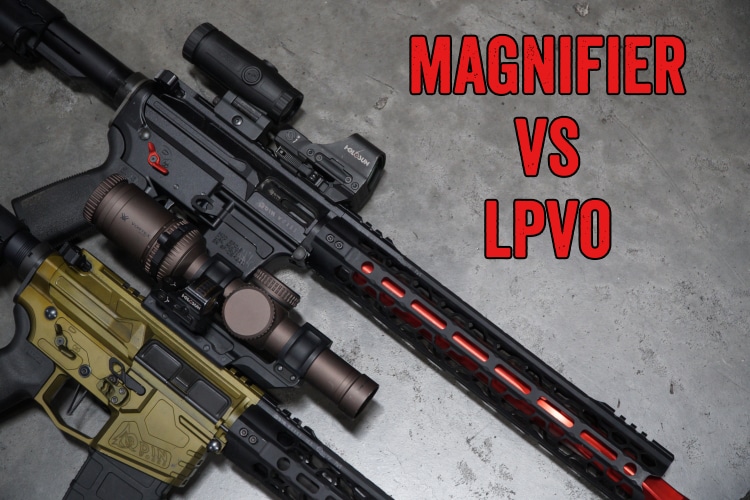
Should You Carry With A Round Chambered?
Explore carrying with a round chambered with True Shot Academy. Learn the benefits of carrying with a round in the chamber and more.

Hey all, we here at True Shot Academy want to go over magnifiers and LPVOs today. These two optic devices are very popular among shooters today. Our mission with this blog post is to compare these two types of optics while delving into some of their traits and features. Without further ado, let’s explore magnifiers and LPVOs.
A magnifier unit is an optical device which is designed to be mounted behind an unmagnified optic. Like the name suggests, these units will provide a fixed level of magnification. Magnifiers typically use mounts which allow them to be flipped out of the way or removed entirely when not in use. Mounts of this type highlight one of the biggest benefits of running a magnifier as one can easily swap between magnified and unmagnified shooting.
One can quickly transition from using just a red dot or holographic sight for up-close shooting to longer range shooting in seconds with a magnifier. While most mounts for magnifiers allow for rapid deployment and removal of the unit, there are also some fixed mounts which exist. These mounts are static in nature and cannot facilitate fast transitions between magnified and unmagnified shooting.
Magnifiers are usually available in multiple magnification levels. These kinds of optics can be had in 3x, 5x, and 6x varieties to name a few. These magnification levels tend to be on the lower side, allowing a user to have a versatile setup which works up close and at further distances. These lower magnification levels can even be appreciated at closer ranges. A shooter will have a better view of their target and can potentially make more accurate shots. This can be the difference between making more more A-Zone hits or not.
A low power variable optic, or LPVO, is a traditional style scope which covers a low range of magnification. Typically, LPVO scopes do not exceed 10x magnification. Common offerings span 1-4, 1-6, 1-8, and 1-10 magnification ranges. These types of optics bridge the gap between close range and longer-range shooting as they seek to cover the low and high ends of magnification. LPVOs are also available with or without illuminated reticles.
LPVOs are also available in either first focal plane (FFP) or second focal plane (SFP) form. FFP scopes feature a reticle which has a size corresponding to the current level of magnification. At lower magnification levels, the reticle will appear to be smaller and more simplistic. As the level of magnification increases, the reticle will grow in size and be at its largest and most complex at the highest level. It is at this highest level of magnification where one can best use a bullet drop compensator (BDC) type reticle and expect a reticle’s markings for holds and other information to be most accurate. SFP scopes feature a reticle which stays the same time at all magnification levels.
As mentioned in the section on magnifiers, a little bit of magnification goes a long way at most distances. LPVOs can make a shooter more accurate at both close range and at further distances. The ability to quickly and easily adjust between low and high magnification levels affords the shooter a great deal of versatility at different ranges.
Pros:
Cons:
Pros:
Cons:
Magnifier units are currently offered by a variety of manufacturers. These companies include Aimpoint, EOTech, Trijicon, Vortex, and Holosun just to name a few. These types of optics are generally manufactured in China and the United States. Magnifiers are available in many different price levels. This means that budget-oriented and premium offerings exist, providing shooters with a variety of budgets to browse potential options.
There number of LPVO offerings on the market considerably outweighs the number of prism sights on the market. Offerings of LPVO scopes can be had from companies such as Leupold, Trijicon, EOTech, Nightforce, and Vortex Optics to name a few. Like most optics, LPVOs are available at both budget-oriented and premium price points. These types of optics are usually made in countries such as the United States, Japan, Germany, the Philippines, and China.
At the end of the day, these two types of optics are incredibly versatile and viable for a wide range of shooters. Optics of both types have been used for competition use, duty use, and casual use alike. Regardless of the optic a shooter ends up choosing, it is important that they train and grow proficient with their firearm. To build proficiency with any firearm, ammunition and time must be invested. While we cannot provide you with time, we certainly have you covered when it comes to ammunition. Happy shooting.
Need bulk ammo? At True Shot Ammo, we have a wide variety of handgun ammo and rifle ammo available to purchase. Please visit our website trueshotammo.com, call us at (888) 736-6587, or you can email us at [email protected] for more ammo options.
View more posts about optics:

Explore carrying with a round chambered with True Shot Academy. Learn the benefits of carrying with a round in the chamber and more.

Explore SBR considerations with True Shot Academy. Learn what an SBR is, how you can legally get one, their pros and cons, and more.

Discover the disposable nature of magazines with True Shot Academy. Learn about why they wear, how to keep your magazines going, and more.